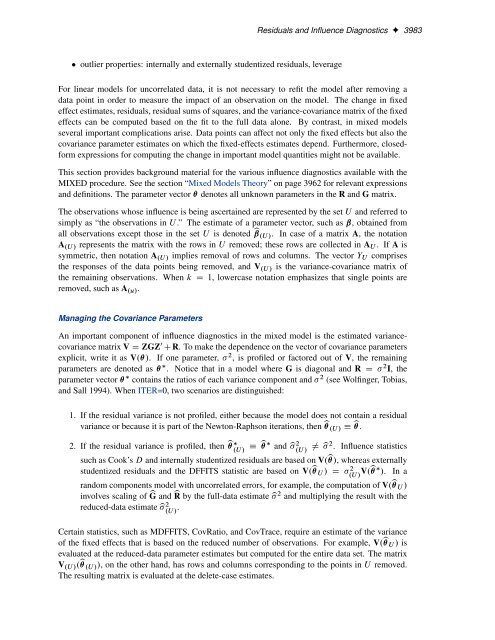SAS/STAT 9.2 User's Guide: The MIXED Procedure (Book Excerpt)
SAS/STAT 9.2 User's Guide: The MIXED Procedure (Book Excerpt)
SAS/STAT 9.2 User's Guide: The MIXED Procedure (Book Excerpt)
You also want an ePaper? Increase the reach of your titles
YUMPU automatically turns print PDFs into web optimized ePapers that Google loves.
Residuals and Influence Diagnostics ✦ 3983<br />
outlier properties: internally and externally studentized residuals, leverage<br />
For linear models for uncorrelated data, it is not necessary to refit the model after removing a<br />
data point in order to measure the impact of an observation on the model. <strong>The</strong> change in fixed<br />
effect estimates, residuals, residual sums of squares, and the variance-covariance matrix of the fixed<br />
effects can be computed based on the fit to the full data alone. By contrast, in mixed models<br />
several important complications arise. Data points can affect not only the fixed effects but also the<br />
covariance parameter estimates on which the fixed-effects estimates depend. Furthermore, closedform<br />
expressions for computing the change in important model quantities might not be available.<br />
This section provides background material for the various influence diagnostics available with the<br />
<strong>MIXED</strong> procedure. See the section “Mixed Models <strong>The</strong>ory” on page 3962 for relevant expressions<br />
and definitions. <strong>The</strong> parameter vector denotes all unknown parameters in the R and G matrix.<br />
<strong>The</strong> observations whose influence is being ascertained are represented by the set U and referred to<br />
simply as “the observations in U .” <strong>The</strong> estimate of a parameter vector, such as ˇ, obtained from<br />
all observations except those in the set U is denoted bˇ .U /. In case of a matrix A, the notation<br />
A .U / represents the matrix with the rows in U removed; these rows are collected in AU . If A is<br />
symmetric, then notation A .U / implies removal of rows and columns. <strong>The</strong> vector YU comprises<br />
the responses of the data points being removed, and V .U / is the variance-covariance matrix of<br />
the remaining observations. When k D 1, lowercase notation emphasizes that single points are<br />
removed, such as A .u/.<br />
Managing the Covariance Parameters<br />
An important component of influence diagnostics in the mixed model is the estimated variancecovariance<br />
matrix V D ZGZ 0 CR. To make the dependence on the vector of covariance parameters<br />
explicit, write it as V. /. If one parameter, 2 , is profiled or factored out of V, the remaining<br />
parameters are denoted as . Notice that in a model where G is diagonal and R D 2 I, the<br />
parameter vector contains the ratios of each variance component and 2 (see Wolfinger, Tobias,<br />
and Sall 1994). When ITER=0, two scenarios are distinguished:<br />
1. If the residual variance is not profiled, either because the model does not contain a residual<br />
variance or because it is part of the Newton-Raphson iterations, then b b. .U /<br />
2. If the residual variance is profiled, then b b and b .U /<br />
2<br />
.U / 6D b2 . Influence statistics<br />
such as Cook’s D and internally studentized residuals are based on V.b/, whereas externally<br />
studentized residuals and the DFFITS statistic are based on V.bU / D 2<br />
.U / V.b /. In a<br />
random components model with uncorrelated errors, for example, the computation of V.bU /<br />
involves scaling of bG and bR by the full-data estimate b2 and multiplying the result with the<br />
reduced-data estimate b2 .U / .<br />
Certain statistics, such as MDFFITS, CovRatio, and CovTrace, require an estimate of the variance<br />
of the fixed effects that is based on the reduced number of observations. For example, V.b U / is<br />
evaluated at the reduced-data parameter estimates but computed for the entire data set. <strong>The</strong> matrix<br />
V .U /.b .U //, on the other hand, has rows and columns corresponding to the points in U removed.<br />
<strong>The</strong> resulting matrix is evaluated at the delete-case estimates.

















